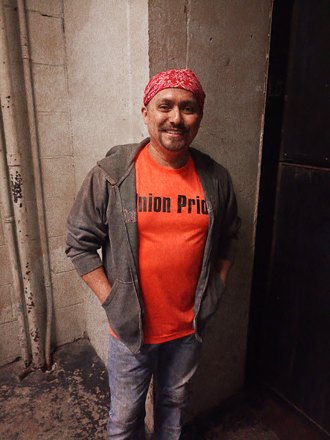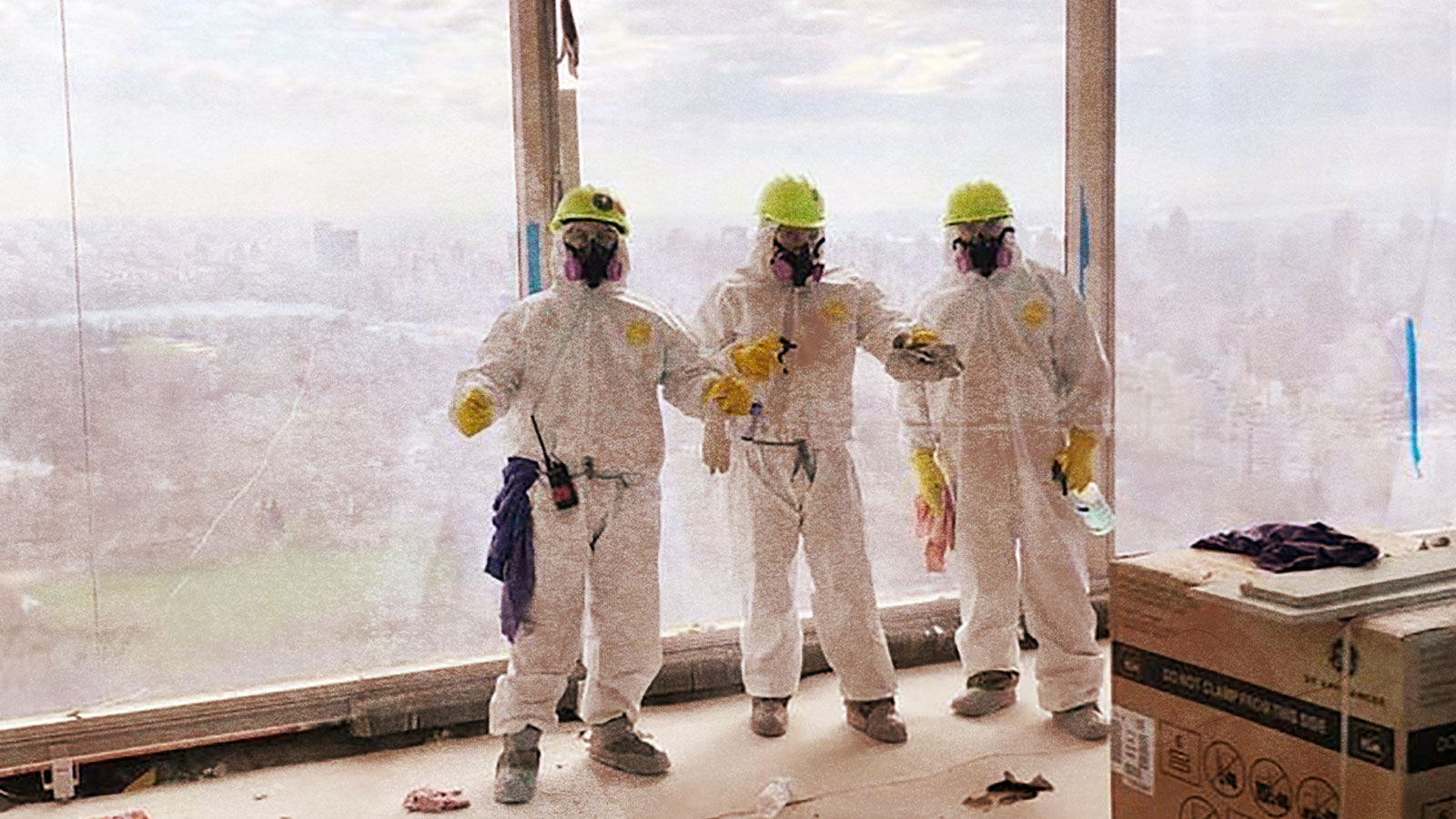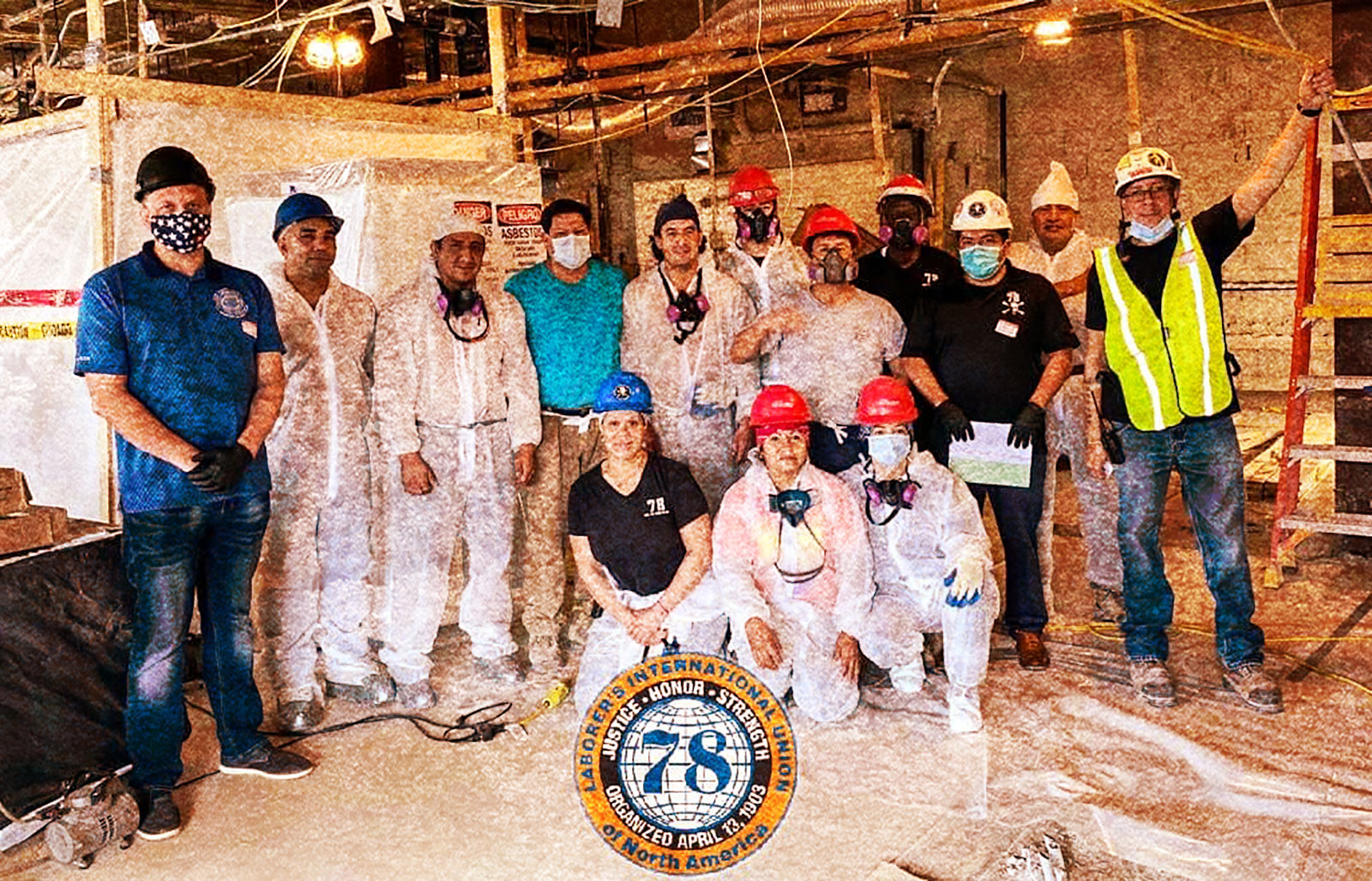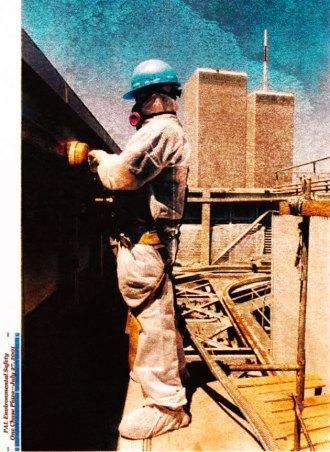It was just before dawn as seven bulky men in T-shirts and sweatpants gathered in front of a towering glass building on Lexington Avenue in New York City. Marcelo Crespo, a 41-year-old with gleaming green eyes and a goatee, beckoned the group over to a white company van, handing each man a pile of protective gear: face mask and respirators, full-body coveralls, shoe covers, hard hats, masking tape.
Clutching their bundles, the men entered through the back door of the building, taking the utility elevator up 32 floors to the roof. The day before, they had sealed up the workspace like an enormous Ziploc bag, covering a large section of the roof with protective plastic structures to shield it from the open air. Before passing through the clear sheeting, Crespo rattled the scaffolding, checking its stability. He traced a sign of the cross on his chest and whispered a prayer that God keep them all safe. Warning signs plastered the makeshift walls, boxes, and equipment. Caution. Danger. Authorized personnel only.
Danger signs in English and Spanish mark the edge of an asbestos abatement site. Grist / Karimala / Getty Images
It could have been a scene from the movie Outbreak, but the job took place several months before the COVID-19 pandemic gripped Manhattan. With every breath, the men were still risking serious health problems – even death – as a result of the microscopic particles of asbestos swirling in the air.
Asbestos abatement workers were deemed essential long before the pandemic. Property owners are legally required to call abatement teams in to remove asbestos any time there’s construction, renovation, or retrofitting. Across the United States, during the coronavirus pandemic, some asbestos jobs have even accelerated as several cities are taking advantage of the closures of public spaces to schedule renovations. And there’s a lot more of that on the post-coronavirus horizon: New York City’s Climate Mobilization Act, which was passed last spring, includes a mandate that the city’s biggest buildings reduce their overall emissions by 40 percent by 2030 and 80 percent by 2050 by installing new windows, insulation, and other retrofits to become more energy efficient.
But while the timing makes sense for cities, it’s not so great for abatement workers, whose occupational risks make them especially vulnerable to serious complications of COVID-19.
Judging from its physical properties alone, asbestos is useful stuff: The naturally occurring mineral’s long, fibrous crystals absorb sound and resist fire, heat, and electricity. In ancient Greek, the word for “asbestos” means “inextinguishable.” By the late 19th century, businesses in Europe and North America were competing for rights to mine it. Asbestos turned up everywhere: concrete, bricks, pipes, flooring, roofing, and couches. It was used as insulation in schools, hospitals, and theaters. Asbestos was used as snow on movie sets in the 1930s, blanketing Dorothy in The Wizard of Oz.
As it grew in popularity, doctors noticed that relatively young asbestos miners were short of breath, suffering from a condition called pulmonary fibrosis. When asbestos fibers become airborne, the small needle-like filaments can enter the body through the lungs and skin, accumulating in internal organs and building up scar tissue over decades. By the time symptoms show up, people might already have permanent lung disease, genetic damage, or cancerous growths.
 Pathologists in the 1960s used post-mortem reports to establish the link between asbestos exposure and the lung cancer mesothelioma. Grist / SSPL / Getty Images
Pathologists in the 1960s used post-mortem reports to establish the link between asbestos exposure and the lung cancer mesothelioma. Grist / SSPL / Getty Images
In the U.S., around 39,000 workers die every year from asbestos-related diseases. About 3,000 of these deaths are from mesothelioma, a malignant form of cancer linked to asbestos exposure. And it doesn’t take much: “Mesothelioma can occur at relatively low levels of exposure,” said Victor Roggli, a professor of pathology at Duke University.
The COVID-19 pandemic makes these workers even more vulnerable. In the past few weeks, Crespo’s Facebook feed has been plastered with pictures of dead colleagues. When the virus was spreading through the city in mid-April, he said his friends were sharing the news of an asbestos abatement worker’s death from COVID-19 nearly every single day: sometimes a single post for several workers, sometimes including links to fundraisers to pay for a funeral.
“Lamentamos ser los portadores de noticias tristes, pero nuestra querida miembro y #Local78 Shopstward Elizabeth Transito Quinde murió debido a complicaciones de #COVID19” read one recent post. We are sorry to be the bearers of sad news, but our dear member and Local78 shop steward Elizabeth Transito Quinde has died from complications of COVID19.
So how do you end up stuck in a job that might kill you?
 Marcelo Crespo. Courtesy of Marcelo Crespo
Marcelo Crespo. Courtesy of Marcelo Crespo
Crespo, a native of Ecuador, started doing asbestos abatement work in 2000, not long after settling in Queens. One day, his landlord suggested he try asbestos removal to pay the rent. He took the first job offered and stuck with it. Crespo said that kind of start is typical for abatement workers, many of whom are persuaded to take a job in the field by a close contact before they truly understand the consequences.
Like Crespo, the majority of workers in the asbestos abatement industry are immigrants, mainly from Latin America or Eastern Europe. The risky nature of the job incentivizes abatement companies to hire undocumented immigrants, people unlikely to sue when something goes wrong.
“We invented mesothelioma, we invented this crisis,” said David Rosner, a historian at the Center for the History and Ethics of Public Health at Columbia University. And the workers fixing the crisis, he said, “are the people with the least amount of power.”
Crespo, who was naturalized 12 years ago, looked around at his group of Latino comrades and agreed: “Americans wouldn’t want to do this job.”
Whatever gets you in the door for abatement work, money tends to be what keeps you there. In New York City today, abatement workers earn around $30 to $80 an hour. As an operation supervisor, Crespo now gets paid at the higher end of that range. But after 20 years of seeing his colleagues die of asbestos-related diseases, he thinks it’s no longer enough to offset the health risks.
“This job is killing us,” he said.
In October 2018, Crespo helped found a support group for New York City asbestos abatement handlers, Amigos x Siempre Club. Their main goal: to help workers in New York City get out of the business alive. Before the COVID-19 pandemic, the group would gather in person every other Sunday in a member’s home or in the back room of a restaurant. They would sometimes bring in instructors to help workers develop skills in leadership, English, economics — anything they think will help workers take up something new.
Since COVID-19, the meetings have moved online. I attended one of the group’s very first meetings, which included around 20 men and women. The members took turns introducing themselves, while a couple of toddlers sat at the back of the hall playing games on their parents’ iPhones sans headphones.
“Bienvenido compañeros a nuestra familia de trabajadores,” said Jorge Roldan, a 46-year-old man in a cancer survivor T-shirt adorned with pink ribbons. Roldan, the president of the group, came to the U.S. from Mexico without papers when he was a child. As an adult, he has survived two bouts of peritoneal mesothelioma. He said doctors saved his life by carving out the contaminated parts of his gut, similar to how he used to carve asbestos-contaminated tiles out of roofs.
At the meeting, Roldan encouraged others to stay positive about their lives: “Today it’s raining,” he said, pointing outside, “and you could stand here and be complaining, coño la lluvia.” Screw the rain. “Or you could think, ‘Finally the plants get a little water.’”
 Local 78 union members offer abatement workers free cloth mask during the COVID-19 pandemic. Grist / Photo courtesy of LIUNA Local 78
Local 78 union members offer abatement workers free cloth mask during the COVID-19 pandemic. Grist / Photo courtesy of LIUNA Local 78
Roldan and Crespo see bringing abatement workers together as an act of resistance and community. Even before the pandemic, the group raised funds through Facebook and GoFundMe for workers who got sick or died. Now Crespo expects that work will double, or even triple, as they try to attend to all the families who have lost their breadwinners to COVID-19.
“Even more people passed away,” he said. “We need to help their families, their kids, help them find a new job.”
Crespo said the threat of contracting coronavirus doesn’t scare him that much, because he’s used to worrying about his health from asbestos exposure. But it’s an added incentive to help others leave the industry, although the current high unemployment rate turns it into a Catch-22: This line of work may be deadly, but it comes with the near-guarantee of a steady paycheck.
Still, the pandemic hasn’t changed Crespo’s own plans to escape. After 20 years on the job, he is trying to get a diploma in financial analysis, taking evening classes while working full time. He’d like to be a stockbroker on Wall Street, but his main goal is to stop doing abatement work.
“Before it’s too late,” he said.
In 1902, the British Inspector of Factories listed asbestos as a harmful industrial substance. And yet over the next several decades, the international asbestos industry continued to boom. In the 1930s, the U.S. asbestos industry successfully lobbied against government regulatory efforts, despite being aware of the health risks. Asbestos was just too profitable to give up, wrote Gerald Markowitz, a historian and professor of occupational safety and health at John Jay College. By 1973, the United States was still using more than 804,000 tons of asbestos per year.
Although asbestos use remained robust in the U.S., in the 1970s the Environmental Protection Agency started taking some measures to limit its use. In recognition of the dangers it poses to human health, the EPA banned asbestos from being used in a handful of products such as insulation spray — something the U.K. had already done back in 1931. Finally, in 1986, the government passed the Asbestos Hazard Emergency Response Act that declared that in places where asbestos fibers could become friable — easily crushed into powder and dispersed into the air — such as building sites, crumbling infrastructure, old constructions, pop-corn ceilings, or places where asbestos insulation had been flocked onto a surface, the material needed to be removed by a team of specialists: abatement workers.
 Grist / Photo courtesy of LIUNA Local 78
Grist / Photo courtesy of LIUNA Local 78
It was the start of a risky business. According to the National Institute for Occupational Safety and Health, some of the riskiest industries for occupational health in the United States are ones that involve exposure to asbestos. Abatement workers who die as a result of their exposure to asbestos fall under what experts call the “third wave” of asbestos deaths — the first two waves affect the miners who dig up the minerals used to make asbestos and the workers who insulated buildings, homes, and schools in the first place. Although abatement work is dangerous, it may also help to prevent a fourth wave of asbestos deaths.
Not every worker wants to get out of the business, either. Some simply want safer conditions: better equipment, better workers protection, and tougher safety regulations at removal sites. That’s the official position of Laborer’s Local 78, New York’s union for Asbestos, Lead and Hazardous Waste Laborers. The group, which also goes by LIUNA Local 78 (a reference to their affiliation with the Laborers’ International Union of North America) has been lobbying the city, state, and federal government for decades to strengthen rules meant to protect workers from asbestos fibers.
In 2018, I met up with Johann Garcia, the then-business manager of LIUNA Local 78, to ask about working conditions. When I walked into his office, he immediately told me it was a bad day: He had just gotten a call from a fellow colleague in the hospital with mesothelioma.
Garcia then reached under his desk and took out a box of porous polypropylene suits. He looked me dead in the eyes. “Wear it,” he said, gesturing to a stack.
At first, I thought he was joking. But he wasn’t. He waited as I put on three suits, one on top of the other — the same kind of layering technique used by abatement workers. Then he had me run — notebook and pen in hand — three laps around the room. It was sweaty work. I giggled mostly out of embarrassment, but I soon understood this was a very serious matter to him.
“Imagine working in that, all day, in whatever weather,” Garcia said. Next, he instructed me to try to rip at the fabric. The papery material came apart easily. “Imagine what that looks like when you’re lifting things and working in building sites.”
 Members of the Local 78 union for New York abatement workers pose for a photo. Grist / Photo courtesy of LIUNA Local 78
Members of the Local 78 union for New York abatement workers pose for a photo. Grist / Photo courtesy of LIUNA Local 78
It’s not just the suits that pose a problem. Respiratory masks, the key elements of the whole protection package, can be a health hazard of their own. Respirators come in three types: half-mask, full-face mask, or powered air-purifying respirator. Workers are supposed to wear the type corresponding with a job’s level of contamination. The more protective the mask, the harder it gets to breathe. In fact, researchers from the University of Eastern Finland found that the use of this equipment can cause cardio-respiratory strain, increasing the heartbeat rate to the point at which it could lead to a heart attack.
In other words, following regulations doesn’t mean workers are necessarily safe. Plus, Garcia said many contractors tend to turn a blind eye to habits that end up increasing worker risks in favor of getting the job done quickly. Workers say sometimes entire rooms undergo abatement without having sealed any windows or openings, letting the debris spread out into the adjacent streets and into the air. Speeding through jobs keeps costs down. The practice of skirting regulations to get out early with a full day’s pay has its own name: “rip and slip.”
“Sometimes you’ll see workers going around with those little white medical masks,” said Regina Santella, a medical expert in occupational carcinogens from Columbia University, “but those don’t do absolutely anything.”
 A histological slide of an asbestos fiber lodged in lung tissue. Grist / Smith Collection / Gado / Getty Images
A histological slide of an asbestos fiber lodged in lung tissue. Grist / Smith Collection / Gado / Getty Images
The New York City Department of Environmental Protection said it regularly inspects worksites. “The DEP inspects active asbestos abatement projects and responds to complaints 24 hours a day in order to ensure workplace safety,” said Edward Timbers, the director of communications. Some workers, however, dispute that.“Wherever construction and abatement companies can cut corners, they will, to save money,” Garcia said.
For his part, Crespo told me that amid the coronavirus pandemic, he’s been going to work in small teams of skilled workers, knowing that his colleagues don’t see anybody outside of their trusted circles. He said he knows many people who haven’t accepted jobs since the virus started. It almost feels like there’s more work, he said, but it’s really just a lack of workers: Some are refusing to take jobs out of fear.
From a societal level, many jobs are both dangerous and necessary: doctors, nurses, and farmworkers to name a few. But asbestos removal work may not fall into that intersection. Some experts say that the legal mandate to abate isn’t backed up by science — and can even backfire, putting more people at risk.
It comes back to the notion of exposure. The danger associated with living or working in an asbestos-insulated building with intact walls (no water damage, no friable roof) is “almost nil,” said Roggli, the Duke professor. But insurance companies don’t like to insure buildings containing asbestos, and banks don’t like to finance the purchase of buildings containing it because of the potential liability (if a resident alleges they got cancer from asbestos in the roof, for example). As a result of those pressures, building owners tend to want to over-abate rather than under-abate.
“At least if you’re abating, it shows that you’re trying – even if it’s the wrong thing to do,” said Rachel Maines, author of Asbestos and Fire. “That’s not necessarily a good reason to do something, but who can blame them. They’re getting sued, so they have to abate.”
Although asbestos is banned in more than 60 countries, in the U.S., asbestos can still be used in many everyday products such as automotive brake pads and gaskets, roofing products, and fireproof clothing. President Donald Trump has, on several occasions, said asbestos has been unfairly maligned, and that it’s “100 percent safe.” Under his administration, the EPA has continued to ignore warning signs provided by government scientists and refused to ban asbestos.
“The failure of the United States to ban asbestos reflects the enormous power of the asbestos industry and its political allies,” writes Richard A. Lemen from the National Institute for Occupational Safety and Health, in a 2017 research paper. “To act against the best interests of public health and to place short-term profits ahead of human well-being.”
 An abatement worker on site in downtown Manhattan in 2001. Grist / Photo courtesy of LIUNA Local 78
An abatement worker on site in downtown Manhattan in 2001. Grist / Photo courtesy of LIUNA Local 78
And it is business: In the United States, the costs of removing asbestos runs into the billions each year. Big buildings can become multimillion-dollar projects: The asbestos abatement of the original World Trade Center was estimated to cost $1 million for every one of their 110 floors.
As New York City works to cut emissions as part of the city’s $14-billion Green New Deal, approximately 50,000 buildings will undergo retrofitting by 2024. Elizabeth Beardsley, a senior policy counsel for the U.S. Green Building Council, said that the effort will translate into more than 20,000 jobs for engineers, construction workers, and abatement specialists like Crespo.
Back at the abatement site, the workers had finished scraping the small portion of skyscraper roofing they had been assigned between the sky and the roof.
They started cleaning up, shoving scraped asbestos and roofing insulation layers into black plastic bags, which were then put into other plastic bags, and wrapped with masking tape. Crespo watched as his crew marked all the bags “toxic” and carted them down the utility elevator — hours of work. The men loaded the boxes into big trucks before changing back into their normal clothes. The five-day job was finished.
Crespo and his men walked outside and for a few moments, they stood still, filling their lungs with city air.
PrintSofia Quaglia | Radio Free (2020-09-08T07:59:38+00:00) Asbestos abatement is one of America’s deadliest jobs. Does it have to be?. Retrieved from https://www.radiofree.org/2020/09/08/asbestos-abatement-is-one-of-americas-deadliest-jobs-does-it-have-to-be/
Please log in to upload a file.
There are no updates yet.
Click the Upload button above to add an update.
